Famous Japanese Paintings and Artists – Japanese Art Styles
The history of Japanese art is one of the most fascinating histories to explore since it covers such a wide variety of mediums, which not only mirror the major cultural changes and influences of Japan, but also showcase the nuanced and complex art styles of Japan. In this article, we will introduce you to the top 13 most famous Japanese paintings and artists, whose contributions to Japanese art history have attracted international audiences and popularized the culture in the global art community. Read on for more about these exciting Japanese paintings and their creators!
An Introduction to Japanese Painting
In Japan, art has been a meditative and creative practice for many ancient Japanese artists since the 7th and 8th centuries and Japan’s indigenous culture. The development of complex artworks originated alongside the emergence of Buddhism as influenced by China. Painting is one of many traditional art forms that dominated Japan and the greater East for many centuries. In Japan, art is centered on the medium of painting since it is recognized as a preferred art form and is quite close to the practice of calligraphy, which relies on the use of a brush to transfer thought and artistic expression onto surfaces.
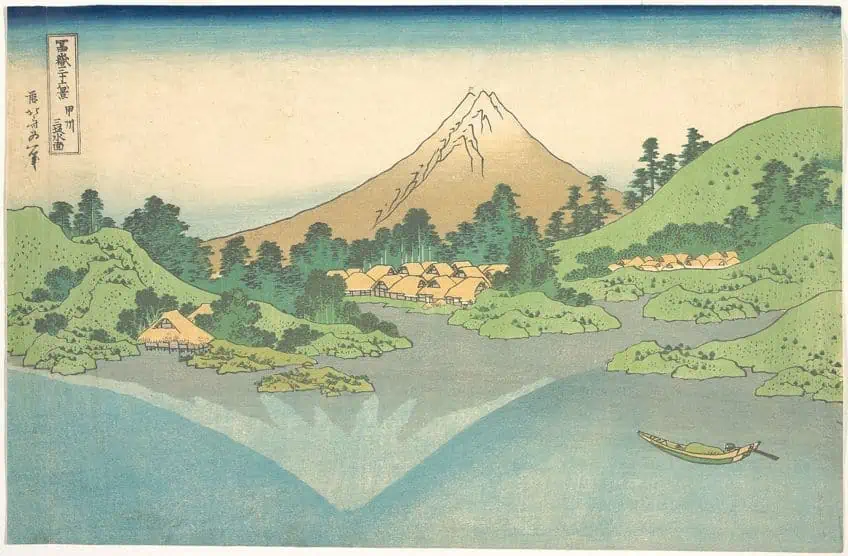
After Japan’s gradual separation from China, indigenous forms of expression spread across the arts community and included the secular and religious arts. Japan’s history of political upheaval and social turmoil is another major contributing factor to the development of unique artistic styles and themes, which we will dive into below.
Popular Styles, Themes, and Motifs in Japanese Artwork
Ancient Japanese art forms included mediums such as pottery, woodblock printing, origami sculpture, silk painting, and traditional ink painting among many other wonderful and unique artistic developments of the culture. Among these different mediums and practices were popular motifs and recurring themes specific to Japanese culture that can be seen in traces of Contemporary Japanese artists today as well as Japanese art styles located in works by European artists. Some of the most famous motifs in Japanese artwork stem from religious belief systems as well as the natural environment, which mirrored the beliefs of ancient and traditional Japanese artists. Art from the Edo period in Japan was a period of great development in the arts and saw art styles such as the Sōtatsu style and Ukiyo-e style in woodblock printing. Many artists working under religious structures such as temples drew inspiration from imported artworks and created their own modified color palettes as seen in vivid colors of the Yamato-e style.
Contemporary Japanese art styles fused with Ukiyo-e painting techniques were also called bunjinga and nanga art styles and were founded on paintings inspired by Chinese artworks.
Ukiyo-e artists chose to represent scenes from everyday life outside of the Tokugawa shogunate while artists who practice the bunjinga art style chose to represent scenes from Chinese culture. With the influx and rise in the influence of European painting in Japan came the introduction of the Technological Art School, which was opened in the late 19th century. This art school employed many Italian educators to promote western techniques in painting. Prominent figures who helped pilot the Western art forms into Japanese culture included. Earnest Fenollosa and Okakura Kazuko. Both of these figures encouraged many Japanese artists to retain the traditional themes and art styles of Japanese culture and traditional practices while fusing their artworks with a more contemporary flair to suit a western audience.
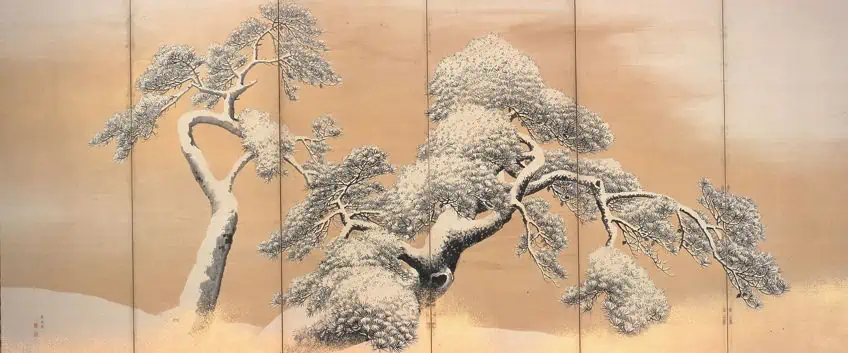
This was a creative strategy that was employed to help promote the Japanese arts and culture to a global audience and thus boosted the Japanese art economy. Following this period, two major Japanese art styles developed in light of the influences of Western painting styles and included the Nihonga painting style as well as the yōga painting style. In traditional Japanese artwork, the format of the vertical hanging scroll was a classical format employed by many traditional ink painters. This format was officially associated with professional colored paintings and was also employed in literati paintings.
The art of inquest painting was another painting technique practiced by many Japanese artists and was found throughout East Asia.
Since the act of Ink Wash painting was so closely associated with calligraphy, the art form relied on specific themes and concepts, which included the consideration of brush, ink, paper, and ink stone as well as the artist’s relationship to each of these key components of ink wash painting. Influential Chinese painters such as Dong Qichang, Wang Wei, Zhang Zao, and many other traditional Chinese artists played significant roles in influencing the art of the broader east as well as setting up a strong foundation from which many Modern and Contemporary artists have sought inspiration.
The Top 13 Most Famous Japanese Paintings and Artists
Now that you have gotten a brief overview of some of the most prominent art styles and trends in Japanese painting, you can now enjoy a glimpse into the top 13 most famous Japanese paintings and artists of all time.
Shaka Rising from the Gold Coffin (11th Century) by Unknown
| Artist Name | Unknown |
| Date | 11th century |
| Medium | Color on silk hanging scroll |
| Dimensions (cm) | 160 x 229.5 |
| Where It Is Housed | Tokyo National Museum, Kyoto, Japan |
Shaka Rising from the Gold Coffin is one of the most famous paintings in Japan, currently housed at the Kyoto National Museum. This mysterious, colorful hanging scroll painting was created by an anonymous artist from the 11th century and is identified as one of the many national treasures of Japan. The scene portrayed in the scroll describes the resurrection of the historical figure Buddha Sakyamuni as described by Mahamaya Sutra. In the painting, numerous radiant rays emanate from Sakyamuni’s body, which is clearly illustrated as each ray contains thousands of Buddhas.
Another striking aspect of the silk painting is the rich colors that the artist chose to use and the lively brushwork that evokes the dramatic nature of the scene.
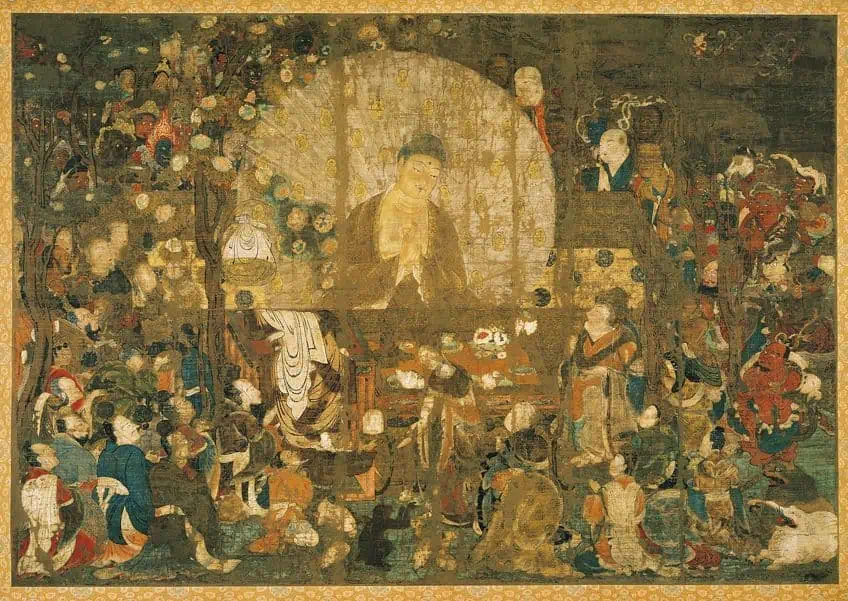
According to the narrative, upon hearing the news of Buddha Sakyamuni’s death, his mother Maya rushed to his grave from the Trayastrimsa heaven. As his mother was grieving, Sakyamuni opened the coffin and rose from his grave using his divine power, and relayed to his mother a message of the transiency of life. After relaying the message, Sakyamuni returned to his coffin. The painting is a wonderful reminder not only of the transience of life but also of the potential for divine miracles and is certainly a painting to remember. Other paintings that are considered to be national treasures include Chinese Lions (16th century) by Kanō Eitoku, Pine Trees in Snow (1773) by Maruyama Ōkyo, and Portrait of Takami Senseki (1837) by Watanabe Kazan.
Mountain Landscape (15th Century) by Tenshō Shūbun
| Artist Name | Tenshō Shūbun (1414 – before 1463) |
| Date | Early-mid-15th century |
| Medium | Ink and color on paper mounted on six-panel folding screens |
| Dimensions (cm) | 172.7 x 304 |
| Where It Is Housed | The Metropolitan Museum of Art, New York City, United States |
This famous ink Japanese painting was created by one of the most famous Japanese artists, Tenshō Shūbun, around the early to mid-15th century. Shūbun was considered to be the founding artist of the Chinese style known as suiboku ink painting, which spread across Japan. The artist was also affiliated with the Zen Buddhist Temple known as Shōkoku-ji and was also influenced by Chinese artists such as Ma Yuan and Xia Gui during medieval Kyoto. In Japan, Chinese ink paintings were of special interest to many elites operating in the Ashikaga shoguns.
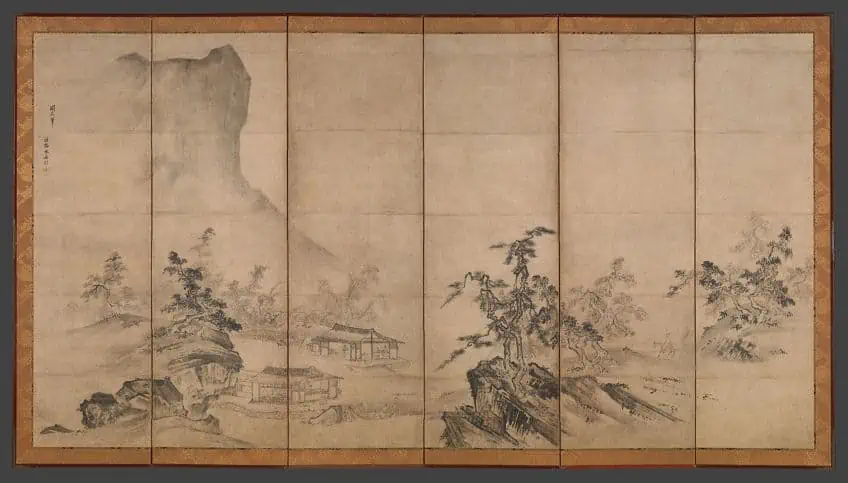
Many elite members of society collected artworks by Chinese masters and often commissioned famous Japanese painters to recreate these Chinese artworks in their Japanese style. The composition in Shūbun’s painting was inspired by a Southern song Chinese painter known as Xia Gui as seen in the rendering of the rock forms, which showcase thick contour lines and ax-cut brush strokes. The artist’s use of “moss dots” as well as trees in the foreground are also recognizable elements of the Japanese style as inspired by works from Xia Gui. It is believed that these paintings were created as two separate works as opposed to a pair since another painter called Kano Yasunobu was also mentioned in the inscription on the painting.
Waves at Matsushima (1628) by Tawaraya Sotatsu
| Artist Name | Tawaraya Sotatsu (1570 – 1643) |
| Date | 1628 |
| Medium | Ink, color, gold, and silver on paper |
| Dimensions (cm) | 3699 x 1660 |
| Where It Is Housed | The National Museum of Asian Art, Washington D.C., United States |
Pause at the National Museum of Asian Art under the Smithsonian Institution. This famous Japanese painting was created by one of the most famous Japanese painters of all time, Tawaraya Sōtatsu. Sōtatsu was known for his calligraphy artworks and was incredibly influential during his time. He’s also most famous for popularizing a technique called tarashikomi, whereby a second layer of paint. Is applied before the first layer can dry. Sōtatsu is also credited with being the founder of the Rinpa School of Japanese painting, as well as Kōetsu. Other notable Japanese artists from the Rinpa school include Ogata Kōrin, Sakai Hōitsu, and Ogata Kenzan.
Waves at Matsushima is one of the most famous Japanese paintings and is considered to be a masterpiece of Sōtatsu.
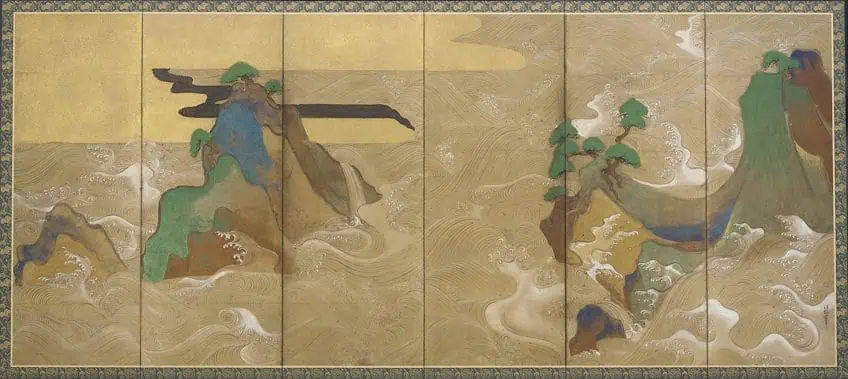
The paintings were created on a pair of folding screens and are among only six surviving artworks made on screens by the artist. Sōtatsu was an innovative artist of his time who created many popular paintings and by the late 17th century, his paintings were recognized by the Imperial court. Sōtatsu Was also awarded the Honorary Buddhist ecclesiastical title called Bridge of the law, which was included in his signature in this artwork. The painting’s title Matsushima refers to the Pine Islands, which was a famous site located near Sendai, a city in the Miyagi Prefecture. In this painting, Sōtatsu used brilliant colors that reflected the mineral pigments of green, blue, and brown, and were further illuminated with touches of gold throughout the painting.
Sōtatsu also skillfully illustrates the relationships between the churning waves, the landscape, and the light, airy cloud forms in contrast to the bending pines. It is believed that these screens were created in the early Kan’ei period of Japan, which lasted between 1624 and 1644 and marked a period of mass cultural change in Kyoto.
White Plum Blossoms and Moon (1755) by Itō Jakuchū
| Artist Name | Itō Jakuchū (1716 – 1800) |
| Date | 1755 |
| Medium | Ink and color on silk hanging scroll |
| Dimensions (cm) | 259 x 97.6 |
| Where It Is Housed | The Metropolitan Museum of Art, New York City, United States |
This stunning ink and color silk painting is one of the most famous Japanese paintings from the Edo period in Japan. White Plum Blossoms and Moon illustrates a stunning array of white blossoms emerging from an old plum tree set against the stillness of the moonlight. The painting was created by one of the eldest sons of a wholesale grocer based in Kyoto. The artist, Itō Jakuchū, was famous during the middle Edo period in Japan, which marked a period when Japan was operating solely on its economy and closed its doors to external influences.
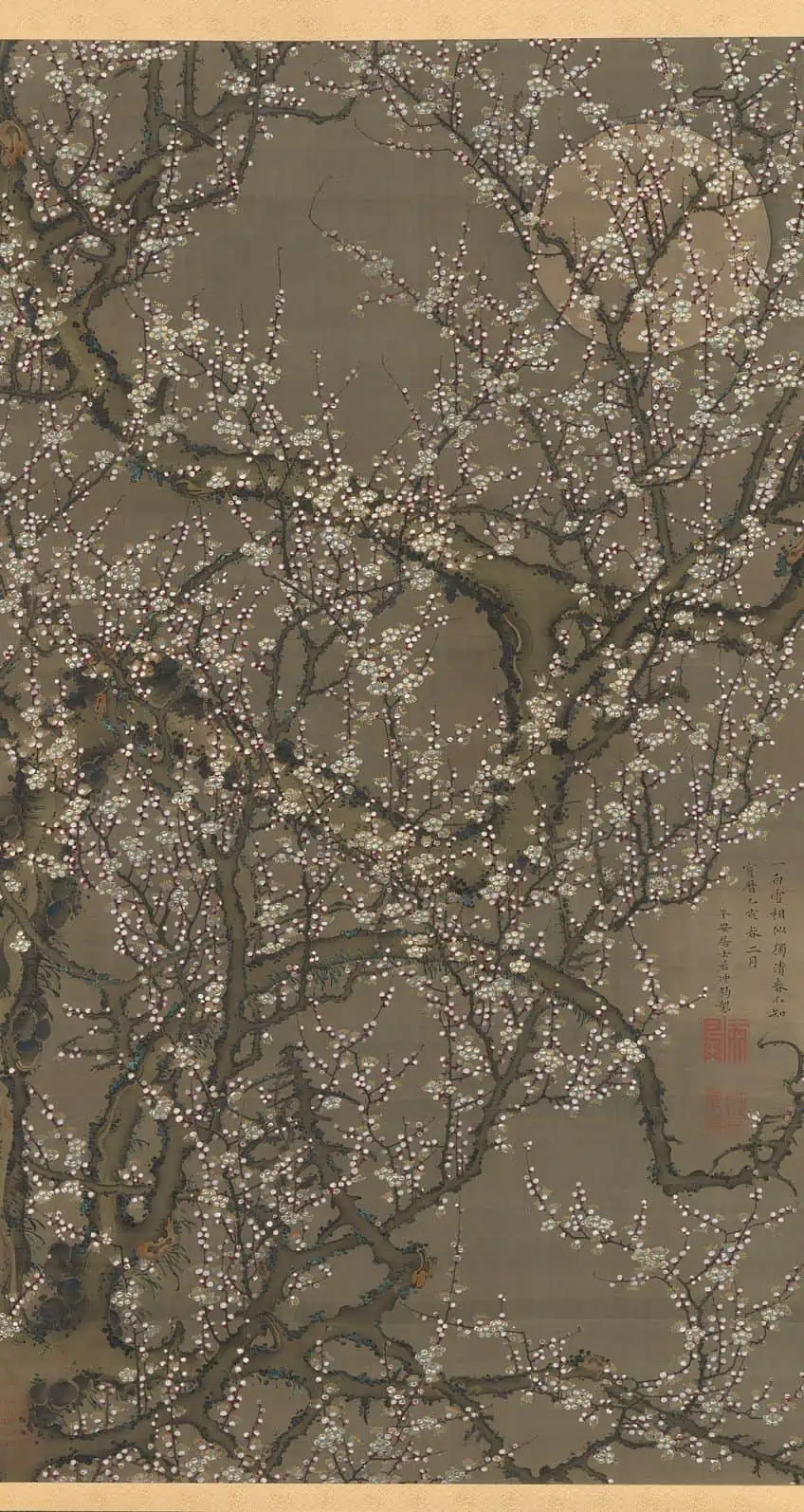
Many of the artist’s paintings deal with traditional subjects and depictions of animals such as chickens and birds. Jakuchū’s experimentation with “modern styles” and perspective in painting can be seen in many hanging scroll artworks. White Plum Blossoms and Moon demonstrates the dream-like vision that Jakuchū was able to translate from real life and reflects his romantic view of Edo-period Japan. Jakuchū was also known to be a very religious man and continued to paint until his death at the age of 85. His Modern elements were found in instances where his work demonstrated “incompatible elements” such as decorative abstraction, Realism, and bright colors for depictions of flora and fauna.
The Great Wave Off Kanagawa (1831) by Katsushika Hokusai
| Artist Name | Katsushika Hokusai (1760 – 1849) |
| Date | 1831 |
| Medium | Ink and color on paper |
| Dimensions (cm) | 25.7 x 37.9 |
| Where It Is Housed | The Metropolitan Museum of Art, New York City, United States |
The Great Wave Off Kanagawa is one of the most reproduced woodblock ukiyo-e prints by Katsushika Hokusai, better known as Hokusai. Hokusai was best-known for printing some of the most iconic Japanese drawings featuring polychrome landscapes that reflect the beauty of 19th-century Japan. This polychrome woodblock print is part of several other prints from Hokusai’s Thirty-Six Views of Mount Fuji series produced in the 19th century. This woodblock ink painting stands out through its use of traditional indigo blue as well as Prussian blue, which were imported during the time from Europe.
Hokusai’s dramatic composition has been used in many popular culture references and was even included in recent Lego sets.
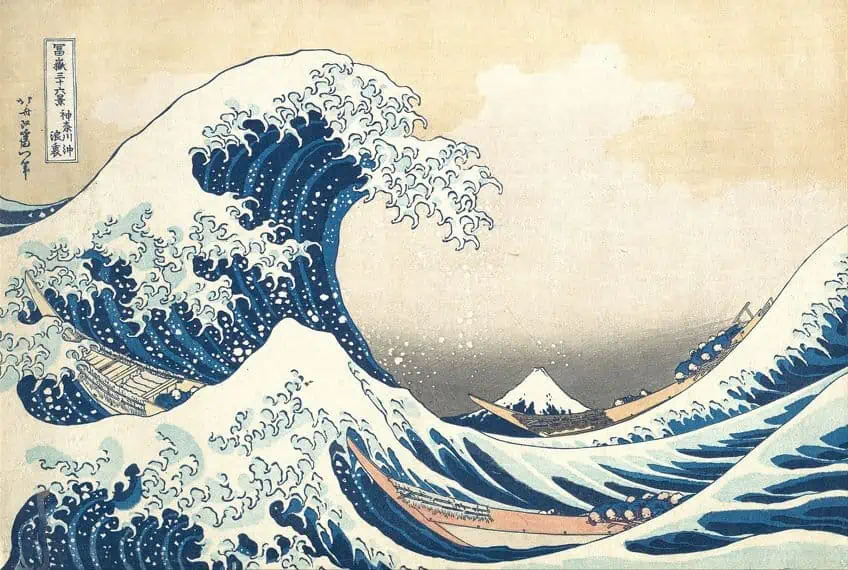
Hokusai was also one of the greatest Japanese painters of all time, whose specialty was in Ukiyo-e woodblock printing. Hokusai was renowned across the world and went through over 30 different artist names throughout his career. Other Hokusai drawings can be found in his manga series, which consisted of 15 volumes, first published in 1814 and ended in 1878. His drawings showcase his mastery over capturing the movement of the human figure through different poses.
Hokusai went on to serve as a great source of inspiration for many post-Impressionist and Impressionist artists, including the likes of Vincent van Gogh and Claude Monet.
Year of the Tiger (1878) by Kawanabe Kyosai
| Artist Name | Kawanabe Kyosai (1831 – 1889) |
| Date | 1878 |
| Medium | Ink and color on paper |
| Dimensions (cm) | Unavailable |
| Where It Is Housed | Smithsonian’s National Museum of Asian Art, Washington D. C., United States |
Year of the Tiger is a Japanese painting by one of the most famous Japanese artists, Kawanabe Kyosai, who paved the way forward for Japanese caricature art in the 19th century Edo period. His works were inspired by artists from the 16th century, including Tohaku who painted large artworks in ink on screens and incorporated powdered gold into the backgrounds of paintings. Year of the Tiger is an iconic painting featuring a small painting of a tiger who appears poised and tame. The painting most likely commemorated the Torah-doshi year or the year of the Tiger according to Japanese culture.
Maiko (1893) by Kuroda Seiki
| Artist Name | Kuroda Seiki (1866 – 1924) |
| Date | 1893 |
| Medium | Oil on canvas |
| Dimensions (cm) | 80.4 x 65.3 |
| Where It Is Housed | Tokyo National Museum, Kyoto, Japan |
Maiko is a famous Japanese painting by Kuroda Seiki, who created some of the most famous Japanese drawings and paintings of the 19th and early 20th centuries. Kuroda is credited with introducing western art theories and practices to the Japanese art scene and is recognized as one of the major pioneers of the Western style of painting. Kuroda was historicized as “the father of the Western-style painting” in Japan, which was best captured in Maiko. In the painting, Kuroda represents an apprentice geisha, also known as a maiko, dressed in a luxurious kimono against a window. Her face is turned towards another young lady who runs towards her and is perceived as an errant girl, eager to share the news with the maiko.
In the distant background, one can see the still waters of the Kamo River.
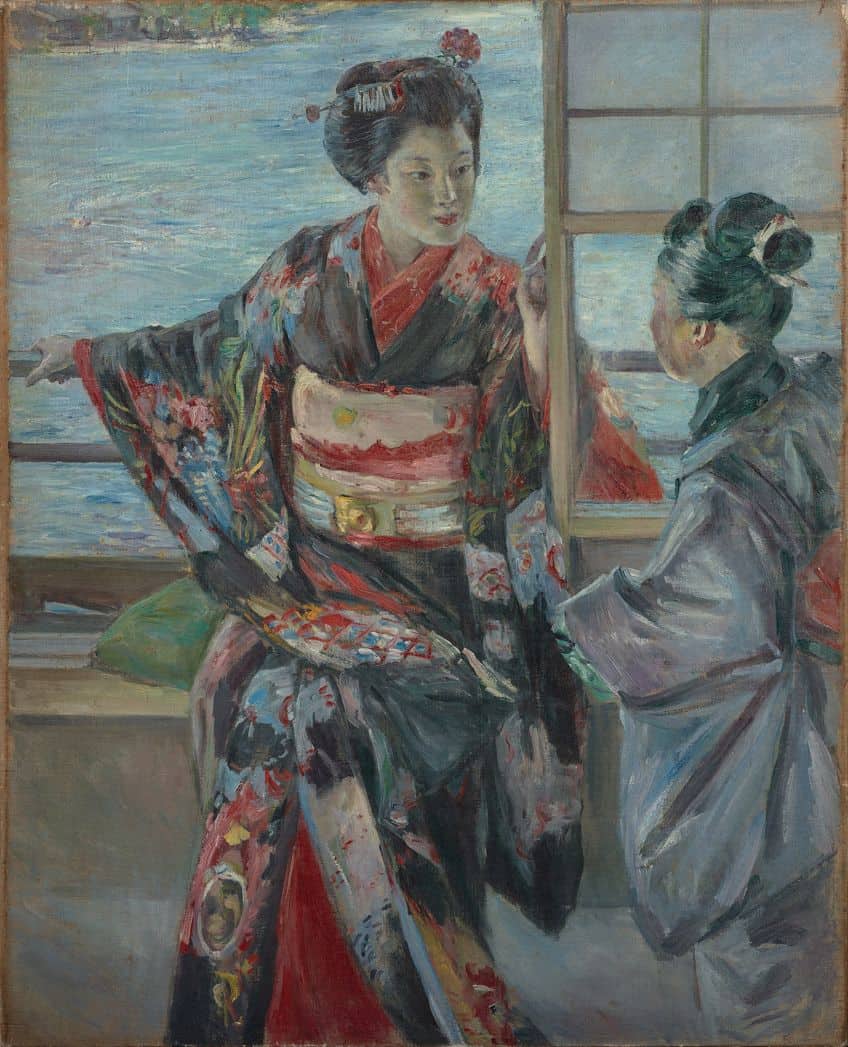
The painting was created when Kuroda journeyed to Kyoto in Meiji 26 after his nine-year-long period of intense study in France. Maiko was inspired by his newfound amazement of witnessing the ancient capital in all its cultural beauty after such a long period away. Kuroda expressed his admiration for the culture of Kyoto by stating that there was nothing like maiko from the Gion district as compared to the rest of the world, indicating his love for his country, culture, and eager return.
Two Divinities Dancing (1924) by Tomioka Tessai
| Artist Name | Tomioka Tessai (1837 – 1924) |
| Date | 1924 |
| Medium | Ink on hanging scroll |
| Dimensions (cm) | Unavailable |
| Where It Is Housed | Tokyo National Museum, Tokyo, Japan |
Tomioka Tessai was one of the most famous Japanese painters of all time, who helped pioneer the Nihonga style. Tessai began his painting practice in the bunjinga style, better known as the literati style, and was one of the last major artists of the movement. The Nihonga Japanese painting style is said to follow the conventions of traditional Japanese art techniques, as opposed to art styles from the West.
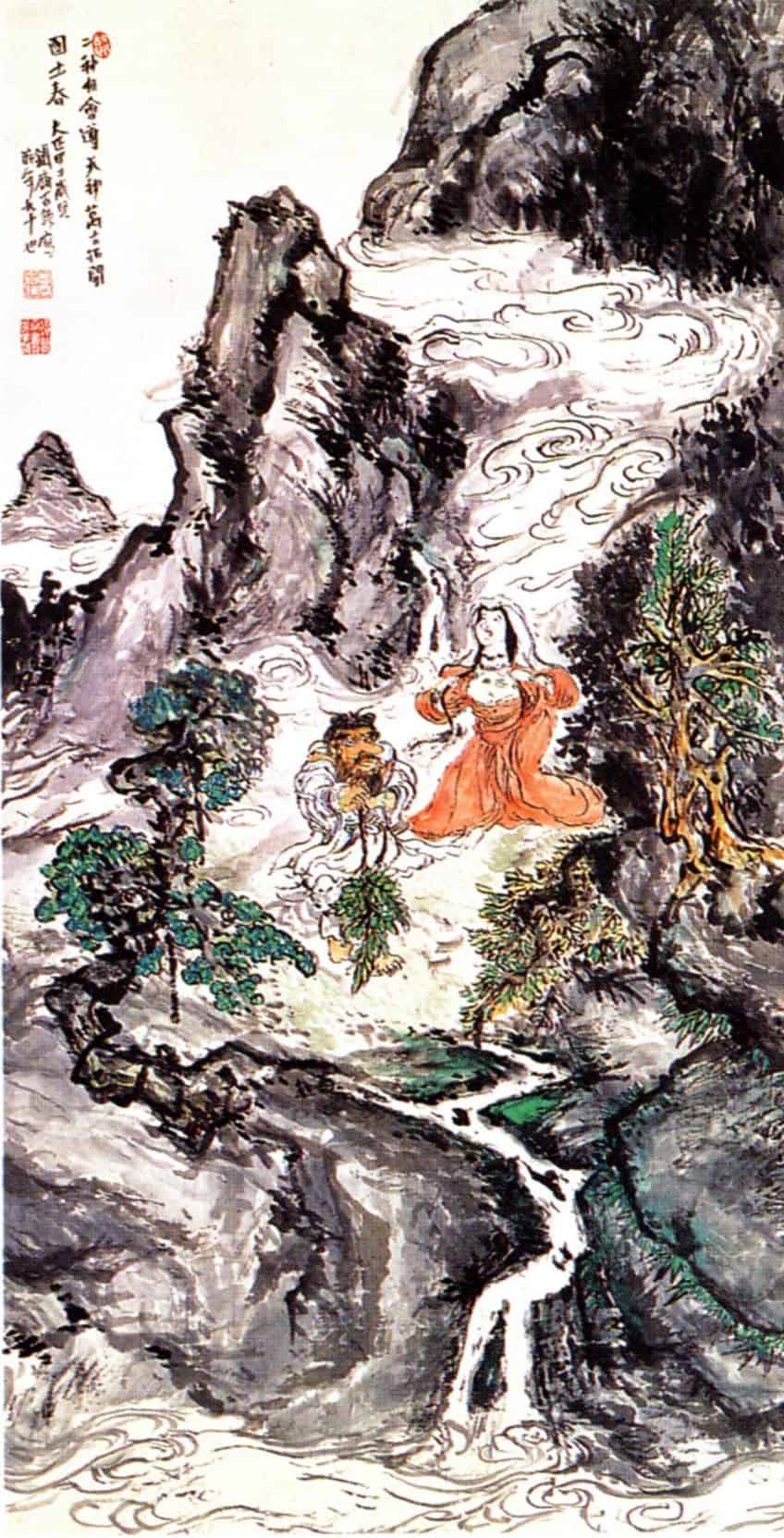
Many of Tessai’s paintings can be admired for their bold and vibrant brush strokes as well as large-scale compositions. Throughout his tenure, Tessai produced more than 20,000 paintings and was incredibly popular during his time. Tessai only reached icon status after his death, as with many other famous traditional Japanese artists. Some of Tessai’s most famous paintings include two divinities dancing, which showcases his hand at ink painting in the traditional hanging scroll format.
Fuji from Kawaguchi Lake (1926) by Yoshida Hiroshi
| Artist Name | Yoshida Hiroshi (1876 – 1950) |
| Date | 1926 |
| Medium | Ink and color on paper |
| Dimensions (cm) | 36.2 x 50.9 |
| Where It Is Housed | Museum of Fine Arts Boston, Massachusetts, United States |
This famous Japanese woodblock print was part of the series Ten Views of Mount Fuji created by Yoshida Hiroshi in the early 20th century. Yoshida Hiroshi was one of the leading artists of the shin-hanga art style that emerged in the early 20th century between the Taishō and Shōwa eras. The development of the shin-hanga movement was based on the resurrection of traditional ukiyo-e art practices, which were popular between the 17th and 19th centuries. Yoshida was trained in Western art styles and used the shin-hanga aesthetic to paint images of landscapes and Contemporary subjects. By 1925, Yoshida established his own printing studio where he combined ukiyo-e printing with the principle of “artist’s prints” derived from sōsaku-hanga to create a third art style that distinguished his art from the former sōsaku-hanga and shin-hanga movements.
Yoshida was invested in his search for innovative and original painting styles and was a great source of inspiration for many Modern artists of the late 20th century.
La Plage (1956) by Kumi Sugai
| Artist Name | Kumi Sugai (1919 – 1996) |
| Date | 1956 |
| Medium | Oil on canvas |
| Dimensions (cm) | 100 x 81 |
| Where It Is Housed | Omer Tiroche Gallery, London, United Kingdom |
Le Plage is among the most famous Modern Japanese paintings created by Minimalist painter Kumi Sugai in 1956. The painting demonstrates Sugai’s exploration of abstraction through clear-cut block shapes and muted colors. Some of Sugai’s key influences include Japanese calligraphy and typography from Western culture. Sugai was born in Kobe and developed an interest in art from an early age. He also attended the Osaka School of Fine Arts in the early 20th century and dropped out to pursue commercial advertising during the Second World War.
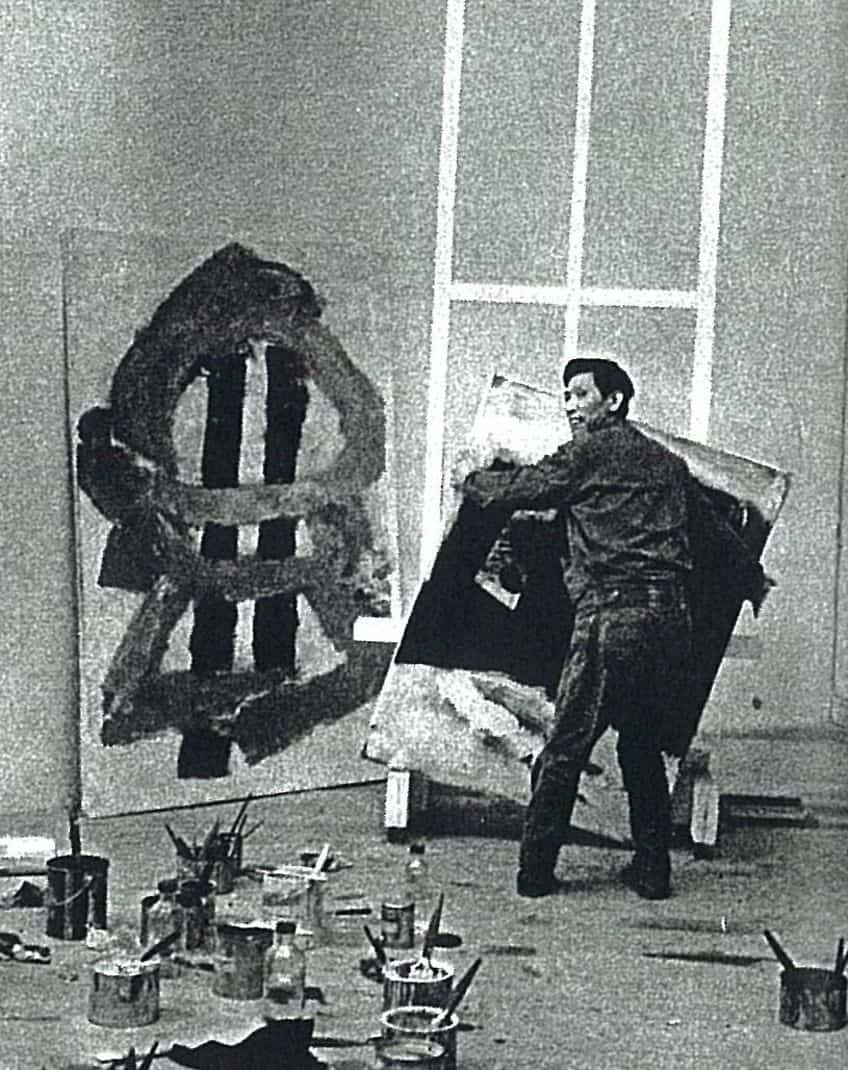
By the mid-20th century, the artist moved to Paris, where he studied at the Academy de La Grande Chaumiere where he studied the dominant Contemporary painting styles of the century such as Abstract Expressionism, Pop art, and Minimalism. Sugai was also influenced by traditional Japanese ukiyo-e woodblock printing techniques and incorporated many bright colors in his paintings as an Avant-Garde approach to fusing eastern and western art styles. It was not long after that Sugai gained global recognition and participated in major global events such as the Pittsburgh International during the late 20th century. Le Plage is among the artist’s highly-priced works with an estimated value of up to $82,000 under the London Omer Tiroche Gallery.
727 (1996) by Takashi Murakami
| Artist Name | Takashi Murakami (1962 – Present) |
| Date | 1996 |
| Medium | Acrylic on canvas |
| Dimensions (cm) | 299.7 x 449.6 |
| Where It Is Housed | Museum of Modern Art, New York City, United States |
727 is one of the most famous Japanese paintings of all time created by Takashi Murakami, who is known as one of the best Modern and Contemporary Japanese painters in art history. Mr. DOB is an alter ego of Murakami who features in 727. Mr. DOB is recognized as an anime character who was created in the hopes of promoting a Japanese icon with a universal appeal compared to the likes of other popular anime characters such as Hello Kitty, Sonic the Hedgehog, and Pikachu.
Other popular motifs in Murakami’s work feature “Superflat” motifs such as jellyfish eyes and smiling flowers, which are characteristic of Murakami’s concepts and promote the “kawaii” aesthetic.
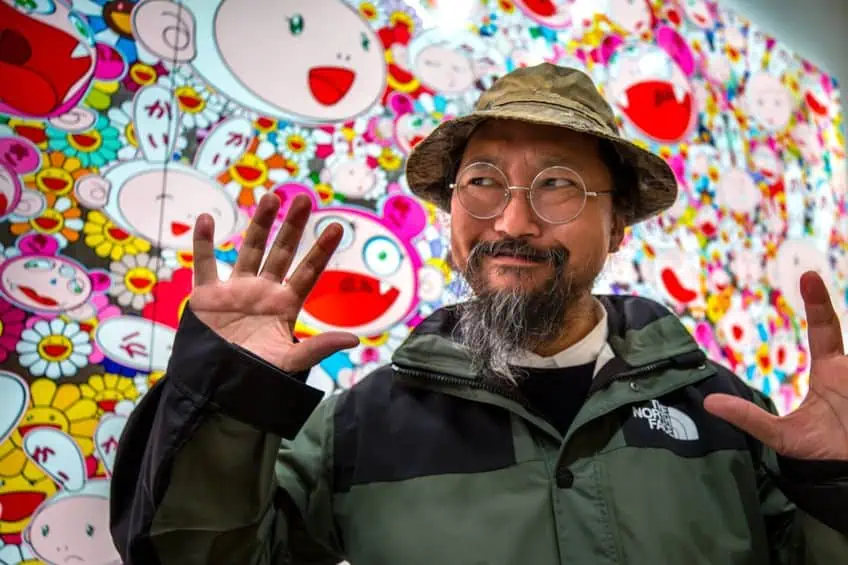 The Museum of Fine Arts in Boston features works by Japanese artist and renowned contemporary artist, Takashi Murakami (unknown date); Citlalivargasss, CC BY-SA 4.0, via Wikimedia Commons
The Museum of Fine Arts in Boston features works by Japanese artist and renowned contemporary artist, Takashi Murakami (unknown date); Citlalivargasss, CC BY-SA 4.0, via Wikimedia Commons
According to Murakami’s statement from a 2001 retrospective, the artist stated that he was inspired by Walt Disney’s Mickey Mouse and was driven to create an anime-inspired character that could appeal to the masses. From an early age, Murakami was concerned with the state of Contemporary Japanese art and pinpointed the issue of the appropriation of Western trends in Japanese art. Through his exploration of two-dimensional images and inspired action from anime and manga sources, Murakami has created some of the most memorable Japanese contemporary artworks to date.
Pumpkin (1998) by Yayoi Kusama
| Artist Name | Yayoi Kusama (1929 – Present) |
| Date | 1998 |
| Medium | Acrylic on canvas |
| Dimensions (cm) | 72.7 × 60.7 |
| Where It Is Housed | Private collection |
Yayoi Kusama is also one of the world’s most renowned Contemporary Japanese painters in the world whose mixed media approach to art makes her one of the best artists to date. Kusama’s ongoing interest in psychedelic colors and the repetition of specific patterns, including polka dots, make her an iconic artist. Pumpkins is a series by Yayoi Kusama whereby she leveraged the repetition of an object from her past in conjunction with the free nature of the spots that decorate it, to generate an “appeal of unpretentiousness”.
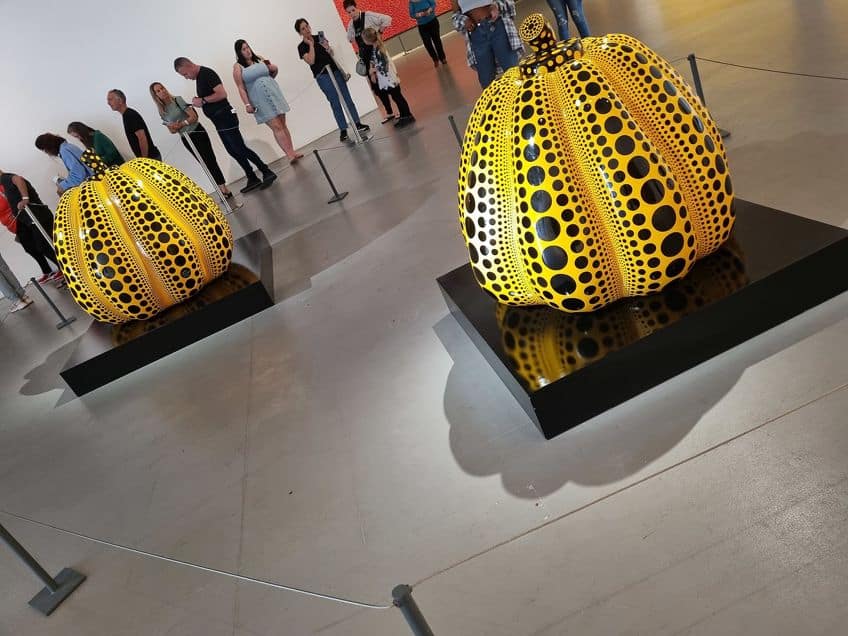
Kusama began drawing these enigmatic pumpkins at an early age during prewar Japan. Her family who owned a plant nursery invited her obsession, which only grew over time and coincided with her obsession for dots. Kusama’s dotted pumpkins appear in many forms, often as sculptures, works on paper, and canvas, which breathes life into the image of the spotted pumpkin and leaves behind an impression of the artist and her past.
Japanese Spirit No. 14 (2002) by Tenmyouya Hisashi
| Artist Name | Tenmyouya Hisashi (1966 – Present) |
| Date | 2002 |
| Medium | Acrylic and gold leaf on the panel |
| Dimensions (cm) | 121.9 x 178.8 |
| Where It Is Housed | Private collection |
Tenmyouya Hisashi is one of the most well-known Contemporary Japanese painters whose artworks recall the Nihonga Japanese painting style called Neo-Nihonga. Tenmyouya also invented a new art style called Butouha, which acts in resistance to authoritative art systems. In 2010, he then established a Samurai aesthetic style called Basara, which echoes the extravagance of the Nanboku dynasty and the Kabuki-mono era. Japanese Spirit No. 14 is one of his most popular Japanese paintings that showcase a fusion of Contemporary elements with traditional Japanese painting styles. The painting features many dismembered body parts that function together as a machine, driven by a human figure, in control of many weapons. The surreal and contemporary twist in the painting is refreshing and adds a sense of awareness around the human form and the roles we play in shaping the world.
These bold, eccentric, and unique Japanese paintings showcase not only the innovative approaches of ancient Japanese artists, but also the different ways in which traditional art styles have influenced Modern and Contemporary artworks. We hope that these Japanese artists and their artworks have sparked your interest in the art forms of Japan and all it has to offer from its rich art history.
Take a look at our Japanese paintings webstory here!
Frequently Asked Questions
Who Is the Most Celebrated Traditional Japanese Painter?
The most celebrated traditional Japanese painter is considered to be Katsushika Hokusai, who is better recognized by his painting, The Great Wave off Kanagawa (1831).
What Are the Most Famous Art Styles in Japanese Painting?
Among the most famous art styles found in Japanese painting are the Kanou style, the ukiyo-e woodblock printing style, the Enzan-Shijou style, and the Yamato-e-style.
Who Is the Most Popular Modern Japanese Artist?
The most popular Modern Japanese artist to date is Yayoi Kusama, who specializes in multimedia artworks, including painting, installation, sculpture, drawing, and many other interactive mediums. Her artworks are considered to be iconic contributions to modern Japanese art, alongside other Japanese artists such as Takashi Murakami and Chiharu Shiota.
Jordan Anthony is a Cape Town-based film photographer, curator, and arts writer. She holds a Bachelor of Art in Fine Arts from the University of the Witwatersrand, Johannesburg, where she explored themes like healing, identity, dreams, and intuitive creation in her Contemporary art practice. Jordan has collaborated with various local art institutions, including the KZNSA Gallery in Durban, the Turbine Art Fair, and the Wits Art Museum. Her photography focuses on abstract color manipulations, portraiture, candid shots, and urban landscapes. She’s intrigued by philosophy, memory, and esotericism, drawing inspiration from Surrealism, Fluxus, and ancient civilizations, as well as childhood influences and found objects. Jordan is working for artfilemagazine since 2022 and writes blog posts about art history and photography.
Learn more about Jordan Anthony and about us.
Cite this Article
Jordan, Anthony, “Famous Japanese Paintings and Artists – Japanese Art Styles.” artfilemagazine – Your Online Art Source. March 31, 2023. URL: https://artfilemagazine.com/famous-japanese-paintings-and-artists/
Anthony, J. (2023, 31 March). Famous Japanese Paintings and Artists – Japanese Art Styles. artfilemagazine – Your Online Art Source. https://artfilemagazine.com/famous-japanese-paintings-and-artists/
Anthony, Jordan. “Famous Japanese Paintings and Artists – Japanese Art Styles.” artfilemagazine – Your Online Art Source, March 31, 2023. https://artfilemagazine.com/famous-japanese-paintings-and-artists/.


